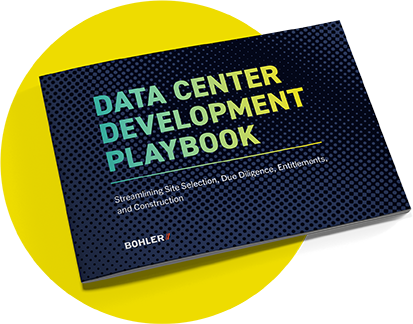Stay in the Know
Get our insights and latest news straight to your inbox.
Designing and obtaining approval for data centers can be challenging, especially when municipal codes and zoning master plans don’t cover them specifically. Data centers may fall under multiple zoning classifications or require unique approval if it’s the municipality’s first encounter with data centers.
However, data centers are still subject to local development regulations and are generally not exempt from traditional permitting and entitlements. Here are the key elements of the data center design and approval process, including standard land development reviews, the duration, and the potential variances that data centers might request due to the lack of direct code provisions.
Due to the absence of data center-specific terms in certain local regulations and zoning plans, these projects often encounter challenges as they may fit into multiple zoning categories or require a customized approval process. This emphasizes the importance of clear communication and collaboration between data center developers and local authorities to streamline approvals.

Typically, the land development process for data centers requires several stages of review and feedback. This comprehensive review ensures compliance with regulations, environmental considerations, and alignment with community goals. The length of this process varies based on factors like the project’s complexity, jurisdictional efficiency, and stakeholder collaboration. Generally, the review process can span six to 18 months to thoroughly evaluate the proposed data center’s design and impact.
See Related: Addressing Community Concerns in Data Center Development
In cases where municipal codes lack provisions for data centers, developers may seek variances and exemptions. These modifications allow the project to move forward while adhering to the code’s overall intent, even if it doesn’t directly address data centers. Common variances include deviations from setback requirements, height limitations, or specific architectural guidelines. Developers often justify these exceptions by demonstrating how their projects align with broader community goals, contribute to economic growth, and provide substantial technological and infrastructure improvements.
To successfully navigate the data center design and approval process, developers, local authorities, and experienced land development and zoning consultants must collaborate. Effective communication and early interaction with municipal planners and power companies enables developers to understand the unique requirements and expectations, allowing them to address potential challenges and delays more quickly.
See Related: Embracing the Benefits of Data Centers
As the demand for data centers grows, it’s crucial to understand the complexities of the design and approval process. Municipalities and developers should work together to update legislation to adapt to this evolving industry. By familiarizing themselves with the typical land development review process, the potential need for variances, and the importance of teamwork, data center developers can streamline the approval process. Through this collaborative approach, data centers can be successfully designed and approved, providing substantial technological advancements while aligning with community goals and objectives.
Get our insights and latest news straight to your inbox.